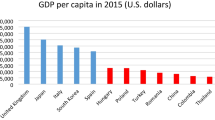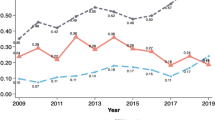Abstract
Openness and Total Factor Productivity in Swedish Manufacturing, 1980–1995. — This paper studies the effect of openness on total factor productivity (TFP) growth. Using industry-level data for Swedish manufacturing from 1980 to 1995, the paper shows that integrated industries tend to be more engaged in R&D and have more entry and exit activity than other industries. The results show that domestic R&D intensity does not contribute to the TFP growth rate. Instead, openness to international markets, which helps facilitate technology spillovers, is an important factor. There is also some evidence that producers exiting the market are less productive, implying that such exits will increase the average productivity of the industry.
Similar content being viewed by others
References
Aghion, P., and P. Howitt (1992). A Model of Growth through Creative Destruction.Econometrica 60 (2): 323–351.
Aghion, P., and P. Howitt (1998).Endogenous Growth Theory. Cambridge, Mass.: MIT Press.
Andersson, L., O. Gustafsson, and L. Lundberg (2000). Structural Change, Competition and Job Turnover in the Swedish Manufacturing Industry 1964–96.Review of International Economics 8 (3): 566–582.
Badulescu, P. (1992). Technologic Knowledge and Economic Growth. PhD Dissertation, Uppsala University.
Barro, R. J., and X. Sala-i-Martin (1995).Economic Growth. New York: McGraw-Hill.
Basu, S. (1996). Procyclical Productivity: Increasing Returns or Cyclical Utilisation?Quarterly Journal of Economics 111 (3): 719–751.
Beath, J., Y. Katsoulacos, and D. Ulph (1995). Game-Theoretic Approaches to the Modelling of Technological Change. In P. Stoneman (ed.),Handbook of the Economics of Innovation and Technological Change. Oxford: Blackwell.
Blomström, M., and A. Kokko (1998). Multinational Corporations and Spillovers.Journal of Economic Surveys 12 (3): 247–277.
Braconier, H., K. Ekholm, and K. H. Midelfart Knarvik (2000). Does FDI Work as a Channel for R& D Spillovers? Evidence Based on Swedish Data. CEPR Working Paper 2469. Centre for Economic Policy Research, London.
Braconier, H., and F. Sjöholm (1998). National and International Spillovers from R& D: Comparing a Neoclassical and an Endogenous Growth Approach.Weltwirtschaftliches Archiv 134 (4): 638–663.
Caves, R. E. (1998). Industrial Organization and New Findings on the Turnover and Mobility of Firms.Journal of Economic Literature 36 (4): 1947–1982.
Coe, D. T., and E. Helpman (1995). International R& D Spillovers.European Economic Review 39 (5): 859–887.
Cohen, W. (1995). Empirical Studies of Innovative Activity. In P. Stoneman (ed.),Handbook of the Economics of Innovation and Technological Change. Oxford: Blackwell.
Cohen, W. M., R. C. Levin, and D. C. Mowery (1987). Firm Size and R& D Intensity: A Re-Examination.Journal of Industrial Economics 35 (4): 543–563.
Davidson, R., and J. MacKinnon (1981). Several Tests for Model Specification in the Presence of Alternative Hypotheses.Econometrica 49 (3): 781–793.
Dinopoulos, E., and P. Segerstrom (1999). A Schumpeterian Model of Protection and Relative Wages.American Economic Review 89 (3): 450–472.
Edwards, S. (1998). Openness, Productivity and Growth: What Do We Really Know?Economic Journal 108 (447): 383–398.
Geroski, P. A. (1991).Market Dynamics and Entry. Oxford: Blackwell.
Griliches, Z. (1995). R& D and Productivity: Econometric Results and Measurement Issues. In P. Stoneman (ed.),Handbook of the Economics of Innovation and Technological Change. Oxford: Blackwell.
Grossman, G. M., and E. Helpman (1991a).Innovation and Growth in the Global Economy. Cambridge, Mass.: MIT Press.
Grossman, G. M., and E. Helpman (1991b). Trade, Knowledge Spillovers, and Growth.European Economic Review 35 (2-3): 517–526.
Gunnarsson, G., and E. Mellander (1999). Input Aggregation Matters a Lot in Productivity Measurement, Even in the Short Run — Evidence from the Swedish Manufacturing Sector 1985–95. Paper presented at the 14th Annual Congress of the European Economic Association in Santiago de Compostela, Spain.
Hansson, P. (1997). Trade, Technology and Changes in Employment of Skilled Labour in Swedish Manufacturing. In J. Fagerberg, P. Hansson, L. Lundberg, and M. Melchior (eds.),Technology and International Trade. Cheltenham: Edward Elgar.
Hansson, P. (2000). Relative Demand for Skills in Swedish Manufacturing: Technology or Trade?Review of International Economics 8 (3): 533–555.
Harrigan, J. (1999). Estimation of Cross-Country Differences in Industry Production Functions.Journal of International Economics 47 (2): 267–293.
Keller, W. (1998). Are International R& D Spillovers Trade-Related? Analyzing Spillovers among Randomly Matched Trade Partners.European Economic Review 42 (8): 1469–1481.
Keller, W. (2000). Do Trade Patterns and Technology Flows Affect Productivity Growth?World Bank Economic Review 14(1): 17–47.
Lawrence, R. Z. (2000). Does a Kick in the Pants Get You Going or Does It just Hurt? The Impact of International Competition on Technological Change in US Manufacturing. In R. Feenstra (ed.),The Impact of International Trade on Wages. Chicago: The University of Chicago Press.
Liu, L. (1993). Entry-Exit, Learning and Productivity Change: Evidence from Chile.Journal of Development Economics 42 (2): 217–242.
Lucas, R. E., Jr. (1988). On the Mechanics of Economic Development.Journal of Monetary Economics 22 (1): 3–42.
de Luna, X., and P. Johansson (2001). Graphical Diagnostics of Endogeneity. Umeå Economic Studies 553. Umeå University.
MacDonald, J. M. (1994). Does Import Competition Force Efficient Production?Review of Economics and Statistics 76 (4): 721–727.
Murphy, K. M., and R. H. Topel (1985). Estimation and Inference in Two-Step Econometric Models.Journal of Business and Economic Statistics 3 (4): 370–379.
Ohlsson, L., and L. Vinell (1987).TillvÄxtens drivkrafter: En studie av industrins framtidsvillkor. Stockholm: Industriförbundets förlag.
Papachristodoulou, C. (1991). FoU, innovationer och produktivitet: resultat och förklaringar. InForskning, teknikspridning och produktivitet. Expertrapport 10 till Produktivitetsdelegationen. Stockholm: AllmÄnna förlaget.
Ramaswamy, K. V. (1999). Productivity Growth, Protection and Plant Entry in a Deregulating Economy: The Case of India.Small Business Economics 13 (2): 131–139.
Rivera-Batiz, L. A., and P. M. Romer (1991). Economic Integration and Endogenous Growth.Quarterly Journal of Economics 106 (2): 531–555.
Romer, P. M. (1986). Increasing Returns and Long-Run Growth.Journal of Political Economy 94 (5): 1002–1037.
Romer, P. M. (1990). Endogenous Technological Change.Journal of Political Economy 98 (5): S71 -S102.
Sapsford, D., and Z. Tzannatos (1993).The Economics of the Labour Market. Basing-stoke: Macmillan.
SCB (Statistiska Centralbyrån) (1992). SE-SIC 92, Swedish Standard Industrial Classification 1992: Explanatory Notes and Conversion Keys. MiS 1992:6.
SCB (Statistiska Centralbyrån) (1995). Stocks of Fixed Assets and National Wealth. N SM 9501 Appendix 3.
Solow, R. M. (1957). Technical Change and the Aggregate Production Function.Review of Economics and Statistics 39 (3): 312–320.
StataCorp. (1999).STATA Reference Manual Release 6.0, vol. 3. College Station: Stata Press.
Stoneman, P. (ed.) (1995).Handbook of the Economics of Innovation and Technological Change. Oxford: Blackwell.
Tybout, J. R. (1992). Linking Trade and Productivity: New Research Directions.The World Bank Economic Review 6 (2): 189–211.
UNDP (1994).Human Development Report 1994. New York: Oxford University Press.
UNDP (1998).Human Development Report 1998. New York: Oxford University Press.
Walfridsson, B., and L. Hjalmarsson (1996). Sources of Productivity Slowdown in Swedish Manufacturing 1964–1989. In D. G. Mayes (ed.),Sources of Productivity Growth. Cambridge: Cambridge University Press.
White, H. (1980). A Heteroskedasticity-Consistent Covariance Matrix Estimator and a Direct Test for Heteroskedasticity.Econometrica 48 (4): 817–838.




